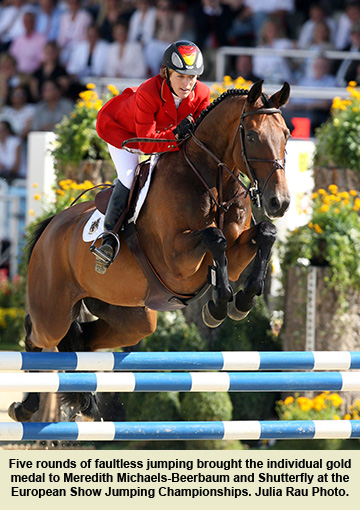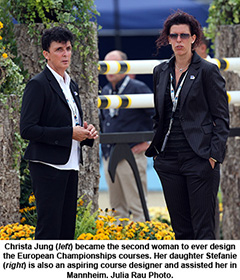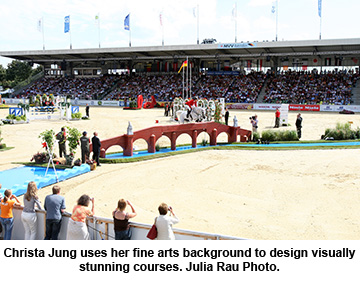
She and Shutterfly didn’t put a foot wrong on their way to the individual gold in a drama-filled few days.
Meredith Michaels-Beerbaum recalled watching Ludger Beerbaum and Jos Lansink ride in the 1988 Seoul Olympics. Then 18 and living in California, where she grew up, Michaels-Beerbaum couldn’t have imagined the conclusion of the European Show Jumping Champion-ships 19 years later.
“It was my dream to compete against these riders, but I never would have believed that I would stand with them on a podium, much less have them standing to my right and left. A dream has come true,” said Michaels-Beerbaum.
In Mannheim, Germany, Aug. 14-19, Michaels-Beerbaum relegated her former heroes, Lansink and Beerbaum, to silver and bronze as she rode Shutterfly to the individual gold.
The individual medal joined the team silver that Michaels-Beerbaum picked up earlier in the week after the German team ceded victory to a determined Dutch team.
Married to Beerbaum’s brother Markus, Michaels-Beerbaum has been representing Germany since the 1999 European Championships. She won the 2005 FEI Budweiser World Cup Final (Nev.) and took team and individual bronze at last year’s World Equestrian Games (Germany), but this is her first individual international championship medal.
More than 11,000 spectators watched as Michaels-Beerbaum entered the stadium aboard Shutterfly for the final round. They’d jumped clean over the four rounds so far and stood in first. Shutterfly soared to yet another clear round, and the gold was hers.
“I am totally happy. I was able to really enjoy today’s final, after the tension had been very high in the beginning of this week,” said Michaels-Beerbaum.
With two clear rounds in the final leg, the 2006 WEG individual gold medalist, Lansink on Al-Kaheel Cavalor Cumano, was able to improve from sixth to second place.
The 14-year-old, gray stallion jumped in an overwhelming manner, leaving a lot of space between him and the fences. Cumano didn’t touch a rail all week, but since his forté is power, not speed, he finished ninth in the first leg, the speed round, and had to work his way up the rankings with relentless clean-round jumping.
Goldfever Returns For Bronze
The winner of the speed leg, Switzerland’s Christina Liebherr on L.B. No Mercy, jumped clean in both the Nations Cup rounds and maintained their lead. But in Round 1 of the last day, L.B. No Mercy caught a rail, dropping them to fourth. And the competition ended for Liebherr in Round 2, when L.B. No Mercy caught a rail in between his front legs in the triple combination and Liebherr retired, with L.B. No Mercy looking slightly lame.
| Ones To Watch Many new faces appeared on the scene at the European Show Jumping Championships. The most successful was Norwegian show jumper Morten Djupvik, whose name had been widely unknown in the international sport before Mannheim. The 35-year-old rider, who works for a Dutch stud farm and is mainly competing young stallions, was in seventh position before the final day and moved up with a clear first round to the bronze-medal rank. With two poles down in the second round, however, he dropped to 10th with the 9-year-old, Holsteiner stallion Bessemeinds Casino. A top-10 finish was a great success for this inexperienced combination. Two other new pairs were less lucky but finished in the top 25. At just 21, Paola Amilibia Puig became the first woman to ride on a Spanish show jumping team at an international championship. Aboard the 16-year-old, French gelding Capri d’Elle, she surprised with sixth in the first leg and added two four-fault rounds in the Nations Cup to her result. It was the first time Puig, who is still in her last year as young rider, had competed in a senior Nations Cup, and it looks as though the economics student from Barcelona might be a future star for Spain. The European Championships marked the team debut of Dutch rider Vincent Voorn, the son of team stalwart Albert Voorn. The 23-year-old jumped double-clean in the Nations Cup to help the Dutch claim team gold, but he and Audi’s Alpapillon-Armanie had eight- and five-fault rounds in the individual final to finish 12th. |
Beerbaum and his veteran mount, the 16-year-old, Hanoverian stallion Goldfever, had been second to Liebherr in the speed leg and picked up no faults in the two Nations Cup rounds. In Round 1 on the last day, they looked to be on their way to another clear round—and the lead—until the second-to-last fence.
A TV camera just outside the ring caught Goldfever’s attention, and he dropped a rail, dropping them to third. The fiercely competitive Beerbaum actually didn’t seem to mind.
ADVERTISEMENT
“If someone had told me some months ago that I would win an individual medal aboard Goldfever, I would have thought he would be dreaming,” Beerbaum said.
Goldfever’s individual bronze was a bonus—Beerbaum was considering retiring Goldfever last year after an injury.
Goldfever has two Olympic Games on his resume, with the 2000 Sydney Olympics team gold, and had earned team gold in the 2004 Athens Olympics before being disqualified for Beerbaum using an ointment with a prohibited substance. When a minor injury took the popular breeding stallion out of the show ring last year, Beerbaum wasn’t sure he’d show him again.
But when Beerbaum’s other rides—Couleur Rubin and Enorm—weren’t ready for the European Championships, Beerbaum looked to Goldfever again.
Beerbaum isn’t sure if Goldfever’s future holds a third Olympic Games. “Considering his age and the length of the trip and the climate at Hong Kong, I do not consider it likely, but I do not want to exclude it. In any case, the European Championship team silver and individual bronze medal would be a nice closing of his career,” Beerbaum noted.
| Championships Tidbits • The teams from France and Ireland finished in 12th and 13th, which means neither nation qualified to send a team to the 2008 Olympics. • Switzerland’s Christina Liebherr, 28, made a quick recovery from a fall at the Aachen (Germany) CSIO in early July. There, she was knocked unconscious and briefly hospitalized. She employed an alternative medicine mental training technique called Emotional Freedom Technique to help regain her confidence. • The Swiss team had to compete minus their star Beat Mändli aboard Ideo du Thot, the 2007 FEI Rolex World Cup Final winners. Ideo du Thot was injured in the warm-up competition on Aug. 14 • Meredith Michaels-Beerbaum won a special prize along with her individual gold—a Holsteiner foal named Emma. |
The Dutch Take Over
While Beerbaum and Michaels-Beerbaum reveled in their individual medals, things didn’t go quite as well for one of their German teammates.
Marcus Ehning’s mare Noltes Küchengirl shocked German fans at the 2006 WEG when she stopped at an unusually shaped wall, but she had seemed to return to form.
But in the speed leg, Noltes Küchengirl slammed on the brakes twice at an in-and-out, eliminating them. The Germans showed their strength, however, as the three remaining team members—Beerbaum, Michaels-Beerbaum and Christian Ahlmann on Cöster all put in top speed-leg performances to put the German team in the lead with a score of 5.18 penalty points ahead of Switzerland (7.13) and the Netherlands (7.37).
But the pressure increased for those three in the Nations Cup. Noltes Küchengirl proved that her dislike for combinations had not dissipated. Going first for the Germans, they had a clear round until the final triple combination, where the 10-year-old, Bavarian mare refused to jump the first element and was again eliminated.
Nevertheless, with clear rounds from the three others, the German team stayed in the lead ahead of the Netherlands. All four of the Dutch riders jumped clear in the first round to put them ahead of Switzerland and Great Britain, who both added 1 time fault.
Ehning’s nightmare continued in Round 2 of the Nations Cup. Two rails fell even before he approached the triple combination, and when Noltes Küchengirl stopped there again, Ehning retired.
The German team could afford no mistakes, so when Ahlmann and Cöster pulled one rail they dropped to silver-medal position.
The Dutch team rode to the challenge and followed up their four first-round clears with three more in Round 2. They added the European Championship gold to the WEG team gold they earned last year at Aachen, Germany.
Three of the Dutch team members were the same as the WEG effort—Albert Zoer on Okidoki, Jeroen Dubbeldam on BMC Up And Down and Gerco Schröder on Eurocommerce Berlin. Vincent Voorn joined them on Audi’s Alpapillon-Armanie, representing his country for the first time.
It was a bitter battle for the team bronze as well. After the Swiss team had accumulated 10 faults in Round 2, it all depended on the last British starter, John Whitaker and Peppermill, who had had just 1 time penalty in the first Nations Cup round.
ADVERTISEMENT
When Whitaker stayed clear, Great Britain held for bronze. The British team consisted of three Whitakers—John, Michael and Ellen—and South African-born David McPherson on Pilgrim II.
Jung Brings An Artistic Eye To Course Design Christa Jung became the second woman to build at the European Championships after Pamela Carruthers designed the courses for the European Championships in 1983. Jung, 52, is the mother of two adult daughters, a teacher at an elementary school, a part-time farmer and an international course designer. To combine all of these tasks is just a question of organization for Jung. “I have always been very farsighted and have been organizing my life in all phases. But, if the whole family did not share my enthusiasm for the equestrian sports and for the course design, it would not be possible,” Jung said. When a woman makes her way in a male-dominated field, directing a dozen assistants with the measuring stick, one has the idea of a determined, resolute and forceful personality. All of these attributes fit her perfectly, but Jung is above all an obliging and friendly person. Jung married her husband, Karl-Georg, at age 21, and he gave her her start in showing and course designing. “I accompanied my husband when he was working as a course designer on horse shows, and I found fun and joy in it myself. So, in 1977, I joined him for a course-designer seminar held by Hauke Schmidt and Arno Gego,” Jung said. For the next 10 years, she served as Schmidt’s assistant at many international shows and was on Gego’s team at the Aachen CHIO (Germany) for many years. Jung, who has trained course designers in the German state of Baden-Wuerttemberg since 1986, has found her own style. Originally, Jung studied fine arts. “Course design has a lot to do with creativity,” she said. “I like the game with the optical effects and different materials. I also want to offer to the spectators also something for the eye. I like to combine parts of the fences in a new manner throughout one horse show. But, I am also someone to whom harmony matters a lot. Everything must fit harmonically together.” During the European Championships at Mannheim, Jung had the help of not only her husband, but also her older daughter Stefanie, who is an architect and plans to apply for her course-design license. Jung has built the courses for the annual Mannheim Horse Show since 1987 and was proud that she had the opportunity to build the Europeans. “As a woman, I have to fight to be equally treated at the top,” she said.
Jung received high praise for her European Championship courses, though some criticized the 28 clear rounds jumped in the first round of the Nations Cup. “I am happy with how things went. The courses were very demanding, but the quality of the rider |
Birgit Popp

 Jung said she’s thought many times about giving up her teaching, but she decided that she wanted to be financially independent of the course design.
Jung said she’s thought many times about giving up her teaching, but she decided that she wanted to be financially independent of the course design.












